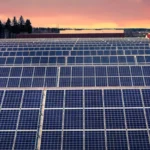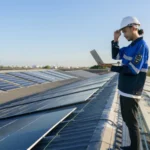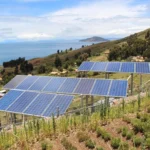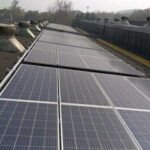How Are Solar PV Modules Made? Complete Guide to the Manufacturing Process
How Are Solar PV Modules Made? Complete Guide to the Manufacturing Process
To make a Solar PV Module, solar cells are joined physically and electrically.
Components of Solar PV Module:
- Glass
- Encapsulant
- Module frame
- Interconnectors
Steps for fabrication of Solar PV Modules:
- Cell sorting
- Contact Soldering
- Series interconnection of cells
- Preparing lamination assembly
- Laminate curing and polymerization
- Module framing & external connections
- Module I-V characterization
The first step is of sorting the solar cells (solar cells are tested and cells from same group are sorted). After sorting of cells, metal contacts are soldered in the form of metal strips, on the front side of the cells. The process of making metal contacts is known as tabbing. After this, cells are connected in series, this process is called stringing.
The above mentioned process can be done both manually and by automated technology. After stringing, stack of connected cells, glass, laminates and tedlar is prepared. After this process, the stack is kept in a machine called laminator. This process is called lamination. After the process of lamination, curing is done, where module is heated. During curing process, the polymerization of EVA occurs (formation of crosslink of chemical bonds). This process of polymerization makes the EVA sheet compact and provides strength and durability for long term. After this process modules are farmed using aluminum frames.
A plastic box containing electrical points for external electrical connection is added at the rear side of module which is called junction box. This junction box also contains bypass diodes. At the end, modules are characterized for their IV curve and power output.
Suggested Articles

Rooftop Solar for Factories: Maximum kW You Can Install
Industrial rooftop solar guide: Understand KW capacity limits, installation guidelines, and best practices for factories and manufacturing units

Delhi Government Pledges to Boost Renewable Energy Generation
Delhi, the capital city of India, is moving towards a greener future with an ambitious plan to generate an additional 6,000 MW of electricity using renewable energy sources.

What Is a Solar Power Generating System? | Complete Guide
A solar power generating system converts sunlight into electricity for residential, industrial, and commercial use. This blog explains the components, working, and benefits of solar systems, helping you understand how to harness solar energy efficiently and sustainably.

Can Solar Systems Support Industrial Motors and Machines? A Complete Guide
Discover how using solar for heavy machines can power industrial equipment reliably and cost-effectively for greener operations.

Net Metering and its Advantages
Net Metering allows solar panel owners to feed excess electricity back to the grid and earn credits, reducing energy bills. Learn the key advantages of net metering for homes and businesses.

Save on Electricity in Haryana Using Net Metering: A Complete Guide
Learn how to save on electricity in Haryana with net metering. Step-by-step guide on benefits, installation, and cost savings for your home or business

How to Improve Solar Panel Performance for Optimal Energy Output
Performance degradation in solar panels reduces energy output over time. This guide explains how to factor in degradation when calculating annual yields, ensuring accurate estimates for residential, commercial, and industrial solar installations.

Solar Projects Challenges in India: Module Supply Shortages and Policy Delays Slow Growth
India’s utility-scale solar projects face delays due to module supply shortages and policy challenges, impacting the growth of renewable energy.